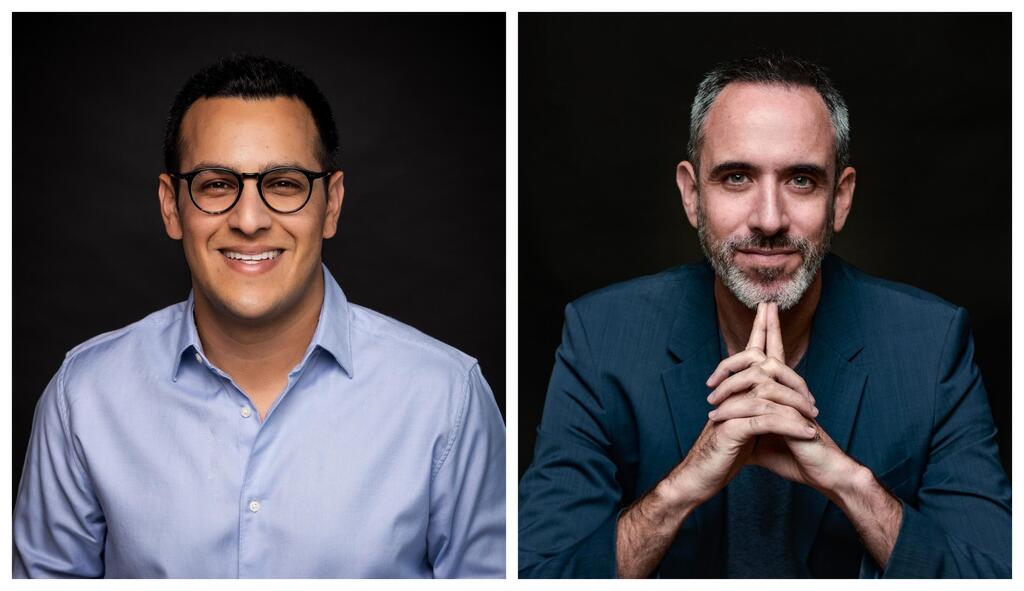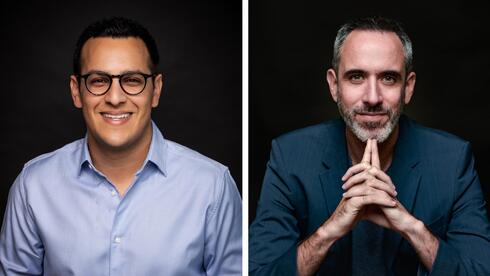“We feel that the HealthTech sector will continue to see significant VC funding in 2023 given the magnitude of the challenges, and therefore opportunity, in the space,” said aMoon. “There is no shortage of healthcare technologies that are addressing big unmet needs, making positive impacts on the world, and possessing the potential to become sizable businesses. In addition, global spend on healthcare is by and large recession-proof, and the healthcare industry is enjoying some major tailwinds.”
While many companies are wary of sectors that might be hit by an impending recession, aMoon believes that the healthcare sector will manage to avoid the pitfalls felt by other industries. populations are aging and this means more people to serve as they reach old age.
1 View gallery


Roy Wiesner and Yaniv Sadka
(Photo: Gabriel Baharlia)
“Demand for healthcare is skyrocketing as the Baby Boomer generation is reaching retirement age,” the firm continued. “Simultaneously, the supply of healthcare services remains limited as clinicians and healthcare practitioners are in shortage. In addition, insurance companies have begun to reimburse digital health and telemedicine because of the pandemic. These vectors create a compelling need and opportunity for technology to step in, reduce costs and workload, and improve efficiency and results.”
Name of fund/funds: aMoon Fund
Total sum of fund: 1.3 billion AUM
Partners: Yair Schindel, Tomer Berkovitz, Todd Sone, Moshic Mor, Yaron Daniely, Gur Roshwalb
Notable/select portfolio companies: Ultima Genomics, MDCloneEleos Health, Lin Health
Roy Wiesner, Managing Director, aMoon Velocity and Yaniv Sadka, Associate, aMoon Velocity, joined CTech to share some predictions for the year ahead.
If 2020 was the year of the pandemic, and 2021 was the year of records, how would you define 2022 in the VC sector?
2022 will be viewed as the year of recalibration. After over a decade of 0% interest rates, low inflation, cheap money, and favoring growth over profitability, the new market and fiscal reality required both VCs and startups to take a careful look at fundamentals.
Emphasis shifted from growth at all costs to sustainable profitability; from the confidence that the next large financing round is around the corner to tightening the belt and evaluating spending to extend the cash runway.
Investors and managers now have more realistic expectations of growth and, consequently, we have seen a reduction in valuations, smaller financing rounds, and a stronger emphasis on sustainable business models. This has been a year of readjusting to a new normal which will stay with us for the foreseeable future.
Who are the big winners of 2022 and why?
The biggest winners of 2022 are:
-
Companies with proprietary technology and strong operational and financial fundamentals; and
-
VC funds who were disciplined with their investments over the last 2-3 years.
We believe that investors who didn’t chase valuations, instead investing in companies with proprietary technology and strong operational and financial fundamentals, will be rewarded for their discipline over the course of this downturn and beyond. It is our view that companies with strong positions in the market will be able to take advantage of the large amount of dry power still available.
We also feel that strategic buyers are winners in 2022. The IPO window has been shut, valuations have been reset, and financial buyers like private equity firms can’t procure debt financing as easily and cheaply as they did over the last few years. This means that strategies can come in more aggressively to win bids for hungry sellers.
Who are the big losers of 2022 and why?
Startups that have raised at inflated valuations over the last couple of years without the fundamentals to support that valuation now need to raise their next round. After they exhaust all other options – venture loans, insider rounds, etc. – they will need to lay off staff, execute down rounds and recaps, and fight for survival.
Naturally, the companies feeling the heat the most right now are high-burn growth-stage companies that never had profitable unit economics in the first place and rode market euphoria to mountain-peak highs.
What do you expect in the VC sector in 2023?
Following the decline in VC investments over the past year, we believe 2023 will see a modest rise as the new reality sinks in and investors’ and companies’ expectations are realigned. There are large amounts of dry powder to be allocated, particularly for those funds that are at the beginning or mid-way mark of their investment period. Investor track record will be looked at more closely in terms of raising new funds. Historically some of the best-performing funds were raised at the height of an economic downturn (e.g., 2001, 2008) and sophisticated institutional investors and family offices are aware of that potential.
At aMoon, we believe that the convergence of healthcare and technology will continue to create remarkable potential to address the most pressing challenges in healthcare and we will continue to make new investments in 2023.
How should different companies (large, medium, early-stage) prepare for the coming year?
Companies across all stages should continue to assess how to extend their runway, across all activities. The HR hiring plan must be continuously assessed against business results. For sales & marketing teams, the expected “ROI” per employee must be taken into consideration to construct a cost-benefit analysis of human capital. Activities should focus on key markets without spreading efforts too thin.
On the revenue side, 2023 budgets should account for the possibility of another year of economic downturn. Generally, it is advisable for companies, particularly those in early revenue stages, not to count on sales revenue as part of their base operating budget. In addition, new financing rounds should provide runway for at least 24 months and preferably longer; sales cycle will increase, R&D will be more expensive, and the assumption should be that it will take more time and money to reach the next major inflection point and raise the next round of capital. Round size should take precedence over valuation.
For those companies that are relatively well capitalized and in a strong position or enjoy “first mover” advantage, this period may offer a significant opportunity to grab market share while competitors struggle to raise funding or need to downsize significantly, and they are advised to structure their budget accordingly.
What sectors in high-tech should we look out for in the coming year – and why?
We feel that the HealthTech sector will continue to see significant VC funding in 2023 given the magnitude of the challenges, and therefore opportunity, in the space. There is no shortage of healthcare technologies that are addressing big unmet needs, making positive impacts on the world, and possessing the potential to become sizable businesses. In addition, global spend on healthcare is by and large recession-proof, and the healthcare industry is enjoying some major tailwinds.
For example, demand for healthcare is skyrocketing as the Baby Boomer generation is reaching retirement age. Simultaneously, the supply of healthcare services remains limited as clinicians and healthcare practitioners are in shortage (e.g. psychologists and nurses). In addition, insurance companies have begun to reimburse digital health and telemedicine because of the pandemic. These vectors create a compelling need and opportunity for technology to step in, reduce costs and workload, and improve efficiency and results.
Finally, the computational revolution in both silicone and software has had an outsized impact on healthcare. The most glaring example of this is the “genomics revolution” that took place over the last decade and continues to have downstream effects. Ten years ago, sequencing one human genome cost about $10,000. Today, it’s approaching $100. That’s a game changer for how we understand genetics and how we identify and design drugs to treat diseases.
Lyfegen, ColTac Therapeutics: aMoon’s notable portfolio companies:
Lyfegen
Digital Health / Healthcare IT: Lyfegen is an enterprise SaaS company that offers a value-based contract management and adjudication platform for pharmaceuticals.
Founders: Girisha Fernando, Michel Mohler, and Nico Mros
Founding year: 2018
Number of employees: 25
Explanation behind investment:
Recent technological breakthroughs are bringing about a wave of new specialty drugs with life changing potential. Unfortunately, patients are at risk of being denied access to these promising new therapies because of their high cost.
Value-based contracting (VBC) is a viable alternative for healthcare payers to only pay for drugs that work. However, the adoption of these contracts has been hindered due to their complexity and the intense administrative burden required to manage them. Lyfegen’s software alleviates these burdens, bringing access and affordability to the world of specialty medicine by enabling health insurers and pharma companies to engage in VBCs at scale.
ColTac Therapeutics
Biotech: Targeted protein degradation, molecular glues
Founders: Prof. Gali Prag, Tel Aviv University
Founding year: 2021
Number of employees: 3
Explanation behind investment:
More than 80% of potential drug targets are undruggable using conventional methods. The ability to “overtake” the cellular machinery responsible for protein stability and degradation and target disease-causing proteins for destruction has recently emerged as a viable alternative to design a new class of drugs called “molecular glues” targeting these important disease-causing proteins. ColTac, a company spun out of Tel Aviv University and formed by aMoon Velocity together with other co-investors, is discovering and developing new molecular glues using its propriety and selective high-throughput screening system.
Credit: Source link


Comments are closed.